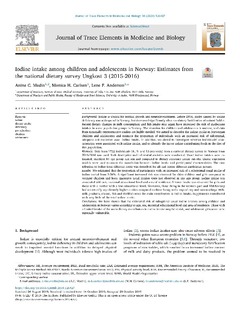| dc.contributor.author | Medin, Anine Christine | |
| dc.contributor.author | Carlsen, Monica Hauger | |
| dc.contributor.author | Andersen, Lene Frost | |
| dc.date.accessioned | 2020-01-22T10:05:27Z | |
| dc.date.available | 2020-01-22T10:05:27Z | |
| dc.date.created | 2020-01-16T20:07:02Z | |
| dc.date.issued | 2019 | |
| dc.identifier.citation | Medin, A.C., Carlsen, M.H. and Andersen, L.F. (2019) Iodine intake among children and adolescents in Norway: Estimates from the national dietary survey Ungkost 3 (2015-2016) In: Journal of Trace Elements in Medicine and Biology 58 (2020) DOI: | nb_NO |
| dc.identifier.issn | 0946-672X | |
| dc.identifier.uri | http://hdl.handle.net/11250/2637433 | |
| dc.description.abstract | Abstract BACKGROUND: Iodine is crucial for normal growth and neurodevelopment. Before 1950, goitre caused by iodine deficiency was widespread in Norway, but decreased significantly after mandatory fortification of animal fodder. Recent dietary changes in milk consumption and fish intake may again have increased the risk of inadequate intakes in some population groups in Norway. The situation for children and adolescents is unclear, and data from nationally representative studies are highly needed. We aimed to describe the iodine intake in Norwegian children and adolescents and estimate the proportion of individuals with an increased risk of suboptimal, adequate and excessive usual iodine intake. In addition, we aimed to investigate whether individuals' characteristics were associated with iodine intake, and to identify the major iodine contributing foods in the diet of this population. METHODS: Data from 1722 individuals (4-, 9- and 13-year-olds) from a national dietary survey in Norway from 2015-2016 was used. Both descriptive and inferential statistics were conducted. Usual iodine intakes were estimated, stratified by age group and sex and compared to dietary reference intake cut-offs. Linear regression models were used to assess the association between iodine intake and participants' characteristics. The contribution of iodine from different foods was described for all and across different participant groups. RESULTS: We estimated that the proportion of participants with an increased risk of a suboptimal usual intake of iodine varied from 3-36%. A significant increased risk was observed for older children and girls compared to younger children and boys. Excessive usual intakes were not observed in any age group. Iodine intake was associated with sex, maternal educational level and area of residence. A lower intake was observed for girls and those with a mother with a low educational level. Moreover, those living in the western part and Mid-Norway had statistically significantly higher intakes compared to those living in the capital city and surroundings. Milk, milk products, cheese, fish and shellfish were the main contributors to iodine intake. Supplements contributed with very little of the total iodine intake. CONCLUSIONS: We have shown that the estimated risk of suboptimal usual iodine intakes among children and adolescents in Norway varies according to age, sex, maternal educational level and area of residence. Those with a limited intake of the main dietary contributors to iodine intake may be at risk, and adolescent girls seem to be especially vulnerable. | nb_NO |
| dc.language.iso | eng | nb_NO |
| dc.relation.uri | https://www.sciencedirect.com/science/article/pii/S0946672X19305528?via%3Dihub | |
| dc.rights | Navngivelse 4.0 Internasjonal | * |
| dc.rights.uri | http://creativecommons.org/licenses/by/4.0/deed.no | * |
| dc.title | Iodine intake among children and adolescents in Norway: Estimates from the national dietary survey Ungkost 3 (2015-2016) | nb_NO |
| dc.type | Journal article | nb_NO |
| dc.type | Peer reviewed | nb_NO |
| dc.description.version | publishedVersion | nb_NO |
| dc.rights.holder | © 2019 The Author(s) | nb_NO |
| dc.source.journal | Journal of Trace Elements in Medicine and Biology | nb_NO |
| dc.identifier.doi | 10.1016/j.jtemb.2019.126427 | |
| dc.identifier.cristin | 1775296 | |
| dc.relation.project | Universitetet i Agder: 689019 | nb_NO |
| dc.relation.project | Universitetet i Oslo: 185511330 | nb_NO |
| cristin.qualitycode | 1 | |

